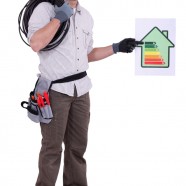How to Achieve Integrated Electrical Services in a South Florida Home or Business
Doing a comprehensive electrical job such as rewiring a building or renovating a business can involve multiple parts and services. All of these pieces need to fit together like a jigsaw puzzle for your project to work smoothly once it’s finished. A good electrical project manager has the knowledge and experience to plan your entire project and to supervise installation of each system and piece of equipment, making sure they work together as one unit. Your goal in renovating or building a new structure should be to achieve integrated electrical services, and a professional electrical manager will make this happen.
Residential Installation
A large residential project such as renovating an entire house requires a delicate balance between electrical loads, and knowledge of how current and projected future use will affect the system. For example:
- Homes built as little as 30 years ago are out of date, in terms of electrical usage;
- More wattage may be needed on the exterior of the home;
- Extra outlets may be needed for multiple kitchen appliances, and
- Constant computer usage adds to the power drain that needs to be planned for.
Your project manager will sit down with you to plan out your entire renovation or new house installation, discussing your lifestyle as well as future plans for the use of the house. Family growth, home office use, and even hobbies and passions can affect residential installation, and each part of the plan needs to work well with all the others. It’s smarter and more efficient to install wiring and appliances you’ll need in the future right away, rather than replacing them piecemeal years in the future.
Generators
Residents in south Florida live with a constant danger of lightning, tropical storms, and hurricanes knocking out power for days at a time. Savvy homeowners and those with businesses know that an installed generator is the best way to ensure a constant power source in case of an electrical emergency. Alternate power sources are the smart way to keep your family comfortable and safe, or to ensure your business is up and running when the power goes out. Electrical project managers know how to determine the size of generator you need for your home or business, as well as how to provide integrated electrical services by combining the generator’s ability with the rest of the systems you are installing.
Energy Efficient Appliances
Homes, restaurants, and even hospitals use appliances on a daily basis, and all can benefit from energy efficient appliances. The savings from installing official Energy Star approved appliances can be significant, and they can have a positive impact on the environment at the same time. The time to install these appliances is when you begin your project, when you and your project manager can coordinate their power usage and fit it in with the general installation plan. Your electrical professional can advise you on the size and style of appliances that fit most with your needs and lifestyle.
Building Codes
Every community has its own particular building codes, and community inspectors must certify that your plans are up to code before allowing your project to go forward. A certified electrical professional knows all about local ordinances, will adapt your plans to fit into existing codes, and will supervise all work to ensure standards don’t slip during the installation.
Project Management
The earlier you contact a professional project manager, the better and more smoothly your project will proceed. An electrical professional is your best ally in creating a coordinated whole-building electrical system. Rather than add or subtract portions of the electrical system piecemeal, he’ll oversee the big picture and set up integrated electrical services from outlets and lighting to circuits and wiring. He’ll ensure that all electrical systems work together, the circuits installed can carry the projected load of all installations, and the entire job is finished and operational in a timely manner.
Read MoreHow Replacing Light Ballasts Reduces a Business’s Electrical Consumption
 Studies show that at least 30 percent of most business’s electric bills are due to lighting. One of the simplest ways you can cut down on your electrical consumption is by replacing your fluorescent bulbs with new, more efficient versions and with the ballasts in the fixtures to go along with them.
Studies show that at least 30 percent of most business’s electric bills are due to lighting. One of the simplest ways you can cut down on your electrical consumption is by replacing your fluorescent bulbs with new, more efficient versions and with the ballasts in the fixtures to go along with them.
The Purpose of Light Ballasts
Light ballasts are devices to limit the current in an electrical circuit. In a fluorescent light, it limits the amount of current that goes through the tube, preventing it from burning out prematurely. Every fluorescent light fixture has a ballast of some type, but newer high efficiency models are designed to work with high performance bulbs that use much less power.
Advantages of New Ballasts
Replacing light ballasts in your place of business will save your company money, but it will also turn your business into a greener, more efficient workplace. Among the benefits are:
- Raising the efficiency of your lighting fixture
- Reducing energy loss
- Creating more light with less power
- Lowering your monthly energy bills
- Reducing residual heat
Types of Ballasts
Fluorescent ballasts come in two varieties, electromagnetic and electronic. If you’ve got older fixtures in your business, your lights may have electromagnetic ballasts installed. They use electromagnetic induction to start and operate the voltages in your light. There is a coil of wire inside these ballasts that combine with an electromagnetic field to transform voltage. These ballasts limit the flow of current to the light but don’t change the frequency of the input power. The bulb will light up on each half-cycle of the power source, which is what causes the signature flickering of most older fluorescent bulbs.
Electronic ballasts, on the other hand, use a solid-state circuit to transform voltage. Unlike the electromagnetic ballasts, they can also change the frequency of the power. This means that electronic ballasts can reduce or even completely eliminate the flickering in your fluorescent lamps. Because of their solid-state circuitry, as opposed to the electromagnetic ballasts’ magnetic coils, electronic ballasts are more efficient and will run cooler.
Financial Benefits
It may seem counterproductive, spending money to replace all the lighting ballasts in your business, just to save money, but they will end up paying for themselves in a surprisingly short amount of time.
- First of all, the reduced use of electricity lowers your monthly electric bill immediately. You’ll see a significant difference in the amount of power you use each month.
- Next, the light ballasts allow less power to flow through the bulbs, so you’ll need to change them much less often.
- Thirdly, the newer lighting system runs much cooler than old fashioned fluorescent lights, so you’ll save even more money by not having to use your air conditioning as much.
- Finally, the fact that you’re using green technology is a great selling point for customers and clients, and may cause an increase in business because of your ecologically-minded business practices.
Make changes today by replacing your light ballasts and reap all the benefits you can. For information and advice or an estimate to fulfill your electrical requirements, contact Static Electric for a free consultation.
Read More5 Steps to Achieving Industrial Energy Savings
Industry uses about one third of all the energy consumed in this country, but most companies don’t have a comprehensive policy for saving energy. It takes a combination of the best technology upgrades and best practice efficiency for your company to show its best reduction in use, but with careful strategy and implementation you can find ways to achieve positive results.
#1: Look for Financial Incentives
Doing an energy upgrade to your business may be a daunting proposition, but there are many financial incentives that can take the sting out of an otherwise pricey project. Commercial and governmental agencies have all given great weight to industrial energy savings, and are rewarding business owners who comply with new standards. Depending on your industry, you may find:
- Loans, rebates, or grants to help cover the cost of any retrofitting or installation of new equipment or supplies
- Income tax deductions for business owners or businesses for following stricter energy use standards
- Reduced sales tax or tax exemptions on certain energy-efficient products
- State government or utility company financial incentives
#2: Review Your Energy Plan
The first step in reducing your industry’s energy use is to develop a comprehensive reduction plan. Get a professional electrical contractor to inspect your physical plant as well as observing your day-to-day operations. New habits and best practices can result in significant savings, just like more efficient equipment can, and an expert will be able to advise you on all aspects of this. Retain a professional commercial designer to develop and lay out a comprehensive plan that show you, step-by-step, just how it will save energy for your business.
#3: Upgrade Your Equipment
The largest investment in your business is doubtless the equipment, and you need to be sure that you have the best, most efficient models of each type in use. Assess each item of equipment to determine whether it’s efficient enough, or if it’s using more energy than a newer model would. The larger the piece of equipment, the more energy savings you can find in most cases. If necessary, obtain expert advice on equipment such as boilers, wiring and circuit breakers, coolers and chillers, internal emergency power sources, and lighting fixtures. Investigate whether it’s possible to renovate your existing equipment for better energy efficiency, and find out what’s involved in specialized installations of any new items.
#4: Change Up the Lighting
Lighting is one of the simplest changes a business can make, and yet it can make a significant difference in industrial energy savings. In some companies electrical lighting accounts for up to 40 percent of the total electrical usage. Change out all your fluorescent and incandescent light bulbs and replace them with more energy efficient LED bulbs. They’re brighter, they use a fraction of the energy as traditional bulbs, and they last years or decades instead of just months.
#5: Invest in Energy Star Certified Equipment
More and more, companies and individuals are making business decisions based on environmental factors as well as economical ones. The Environmental Protection Agency has an Energy Starcertification program for industrial plants. If your company falls within their performance levels, you’ll be eligible to display the Energy Star logo and advertise as a certified green industry. With all the interest in green living and the environment, this certification can be a large factor in business decisions, and an edge you’ll have over your competitors.
Contact us for help developing a comprehensive industrial energy savings program from strategy through to final inspection.
Read MoreHow to Lower Your Utility Bills Through Home Energy Efficiency
One of the best ways to save money is not to spend it in the first place, and nowhere is that more evident than in your utility bills. A few basic changes can make significant marks on the amount of your electric and gas bills, while giving your home an energy makeover can save you up to half the amount you pay each month.
The first step is to assess your home for energy leaks and waste. Take a long look at your entire structure, from the attic to the basement, to determine where heat and cold are leaking out, what appliances should be replaced, and where you’re wasting money on utilities. Look for actual cracks or holes in walls, and feel for cold drafts around windows and doors. Be very critical; attention to detail now will pay off later in home energy efficiency.
Insulating and Sealing
Sealing in your home prevents hot or cold air from leaking out of small areas in your house. Insulating does the same thing for whole huge parts of the home. Both can contribute significant savings when done right, but not every home needs every technique done. Prevent wasting money by doing one or more of these tasks:
- Install weather stripping around all doors that lead to the outside
- Seal and caulk around all the windows in your home
- Seal air leaks around plumbing that goes into the wall
- Seal around the dryer exhaust where it vents outdoors
- Add insulation to the attic
- Insulate all heating ducts
Using Your Equipment Efficiently
Insulating and sealing your house will take care of the passive waste, the slow leaking that happens every day regardless of what you do. Make an even bigger impact on home energy efficiency by tackling active waste: the waste that you can prevent by making better choices and using your equipment more efficiently. Develop some useful habits that will save you money, year after year.
Change the air filter regularly, at least four times a year. Check it monthly, and change it if it’s dirty, but never go longer than three months before switching to a new one. Use a HEPA filter instead of the cheaper basic model and you may end up saving money on allergy medicines as well as utility bills.
Install a programmable thermostat to control your heating and cooling. Turning your air up and down are great ideas as you leave the house and return, but hardly anyone remembers every single time. A programmable thermostat will allow your system to work at a minimum level while you’re gone to work or school, and activate to a comfortable level right before you get home.
Get Regular Maintenance
Have your HVAC system serviced once a year. A professional will clean out your ducts, allowing air to move more efficiently through the house. Open ducts mean that your system doesn’t have to work so hard, which saves you money throughout the year.
Change Your System
Replace your heating and cooling system with a more efficient Energy Star system. If your furnace and air conditioning system are more than 10 years old, or if they’re simply not keeping you comfortable in extreme weather after you’ve sealed and insulated the house, it’s time to replace the old model for a newer version. One that’s Energy Star rated can save you enough money in home energy efficiency to eventually pay for itself over a decade or so, depending on how inefficient your old model is.
Read More
How to Save Electricity
Turning your business a little greener is good for the environment, but it has the added bonus of giving your business hundreds of dollars in electricity savings. Decreasing your power usage gives you a lower bill, and one of the simplest ways to do this is to adjust your business’ lighting. Make a few simple changes and you’ll save on lighting, enough to pay for the changes themselves in just a few months. In the meantime your customers and clients can feel good, knowing they’re frequenting an environmentally aware business. These handy tips will help you learn how to save electricity.
Lighting After Hours
There’s a fine line between security and wastage when it comes to keeping the lights on after your business is closed. If you don’t feel comfortable leaving the building completely dark, install strategic LED lights to lighten crucial areas, and make sure employees turn out all other lights when the business is closed. Consider installing a timer to turn out all the lights after a certain time of the day.
Save on lighting the outside of your building by replacing your old floodlights and security lights with motion sensor or infrared lighting. The lights will only be used when needed, as well as alerting people around the building that something is wrong.
It’s the Simple Things
Often small actions can make big changes. This is true for ways to save on lighting as for anything else.
- Clean your signage. Dusty and dirty signs look dimmer, plus they cause excess heat to build up, using extra power.
- Change your décor. Paint the interior of rooms lighter so they look brighter inside. Make it a policy to open blinds or drapes during the day to let in sunlight and reduce the need for interior lighting.
- Change your bulbs. Incandescent and halogen bulbs use much more electricity than newer fluorescent and LED bulbs. Change out all the bulbs in your business and you can see significant savings.
During Working Hours
Of course you have to keep the lights on during working hours, but you can still find significant savings by making a few simple changes and enforcing good habits with your employees. Consider installing a skylight to let in more natural light, as well as lighter blinds instead of darker curtains. Allow as much natural sunlight as possible to flow into the building. Install a dimmer switch in the main work area to reduce the amount of electricity used without completely turning out the lights.
If you have work areas that are not in constant use, install a motion detector on the lights to make sure no one leaves them on all day. Encourage your employees to turn off all lights that aren’t in use, from outdoor landscape spotlights to the lights in the bathroom when they aren’t being used. Timers and motion sensors can give you big savings on lighting in every part of the building that isn’t in constant use.
Read More




Recent Comments